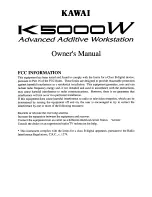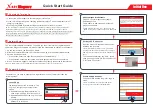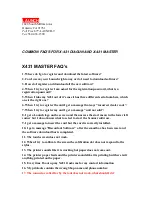
39
This is caused by both halves of the output stage (Q1, Q2 on positive side, and Q8, Q9 on
the negative side) being turned off right around crossover (crossover from positive drive to
negative drive). This actually takes a small chunk (sometimes only visible in distortion
waveform) out of the center of the output waveform. This also causes some harmonic
distortion. Remove input signal to amp and measure DC voltage across emitters of Q2 and
Q8 (TP3). Bias adjustment, R17, should allow adjustment from zero volts to well over 10mV.
4.
Bias Reference Test.
The purpose of the bias reference circuit is to provide bias to the driver and output transis-
tors to just barely turn them on. Q10 is a positive current source and Q12 a negative current
source. The voltage between the collectors of Q10 and Q12 is regulated by the bias refer-
ence.
A voltage of around .6V is required across the base emitter junction of a transistor to begin
to turn it on. Since a total of 4 junctions are in the current amp (Q3, Q1, Q7, and Q8) the
bias reference needs to have around 2.4V (4 drops) across it to turn on all four transistors
in the current amplifier.
The range of adjustment is very small (Between 1.7V and 2.8V when R17 adjusted from
stop to stop). The reason the adjustment range is small, is because very little change in
voltage across the reference produces radical bias current changes in the output stage
(Due to the logarithmic relationship between base emitter voltage to collector current). Too
great a range results in a control that is very hard to adjust.
If there is excessive power pulled from AC line or crossover distortion, this is due to exces-
sive voltage across reference. The range (measure across C2) should be 1.7V to 2.8V. if
not check R15, R17 (pot), R13, and Q5.
5.
After amplifier heats up, bias current and power pulled from AC line, increases.
This is due to the fact that the bias circuit not tracking the current amplifier with temperature.
Make sure that all of the transistors, Q1, Q2, Q3, Q5, Q7, Q8, and Q9 make good thermal
contact with the heatsink (Hardware is tight, adequate thermal grease is on devices, insula-
tors, and heatsink). If all of this is OK replace Q5.
Содержание EON15
Страница 23: ...High Frequency Response EON Power15 and EON15P 1 230 33...
Страница 24: ...Low Frequency Response EON Power15 and EON15P 1 230 34...
Страница 30: ...Low Frequency Response EON PowerSub 40...
Страница 35: ...High Frequency Response EON Power10 45...
Страница 36: ...Low Frequency Response EON Power10 46...










































